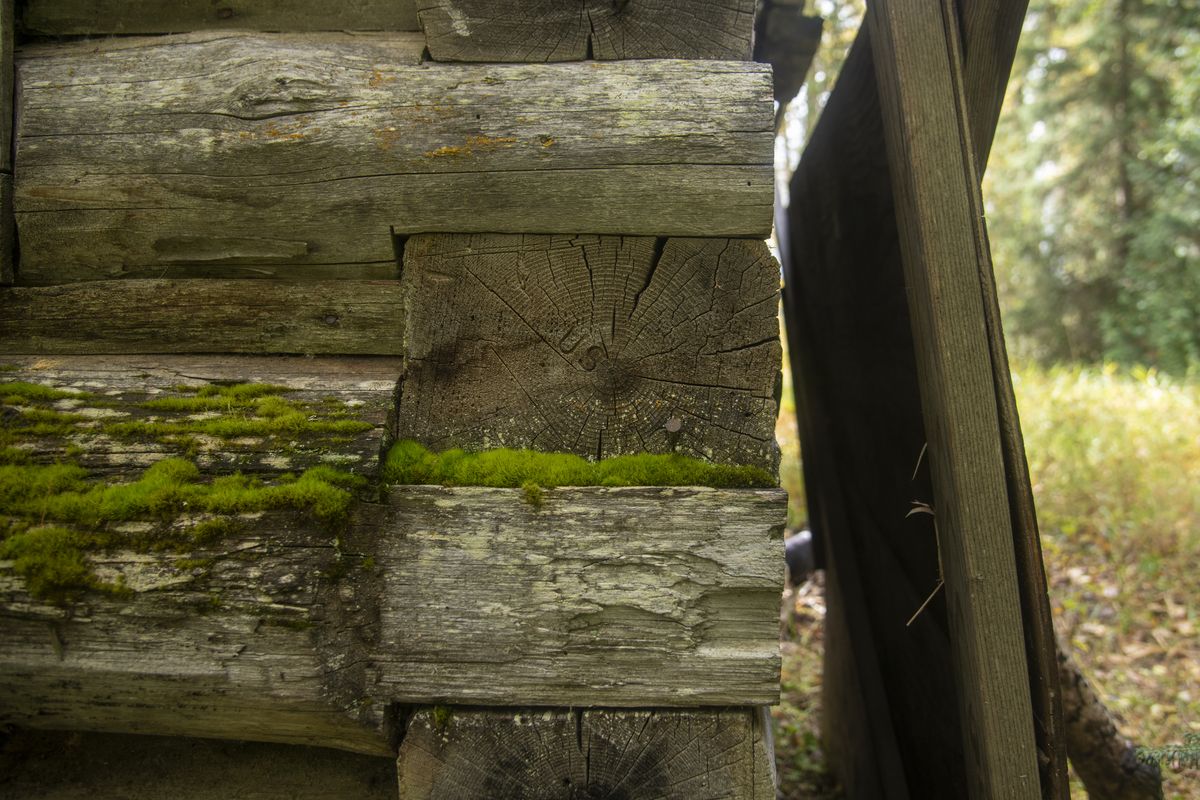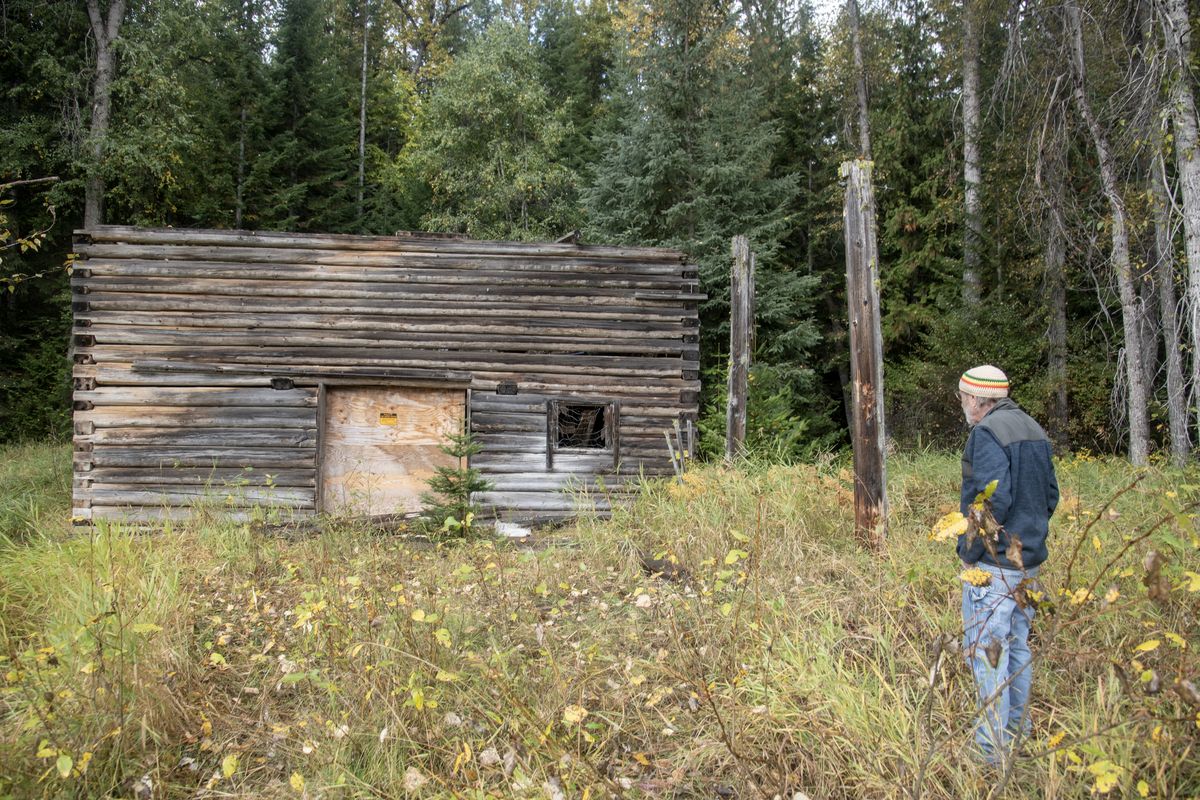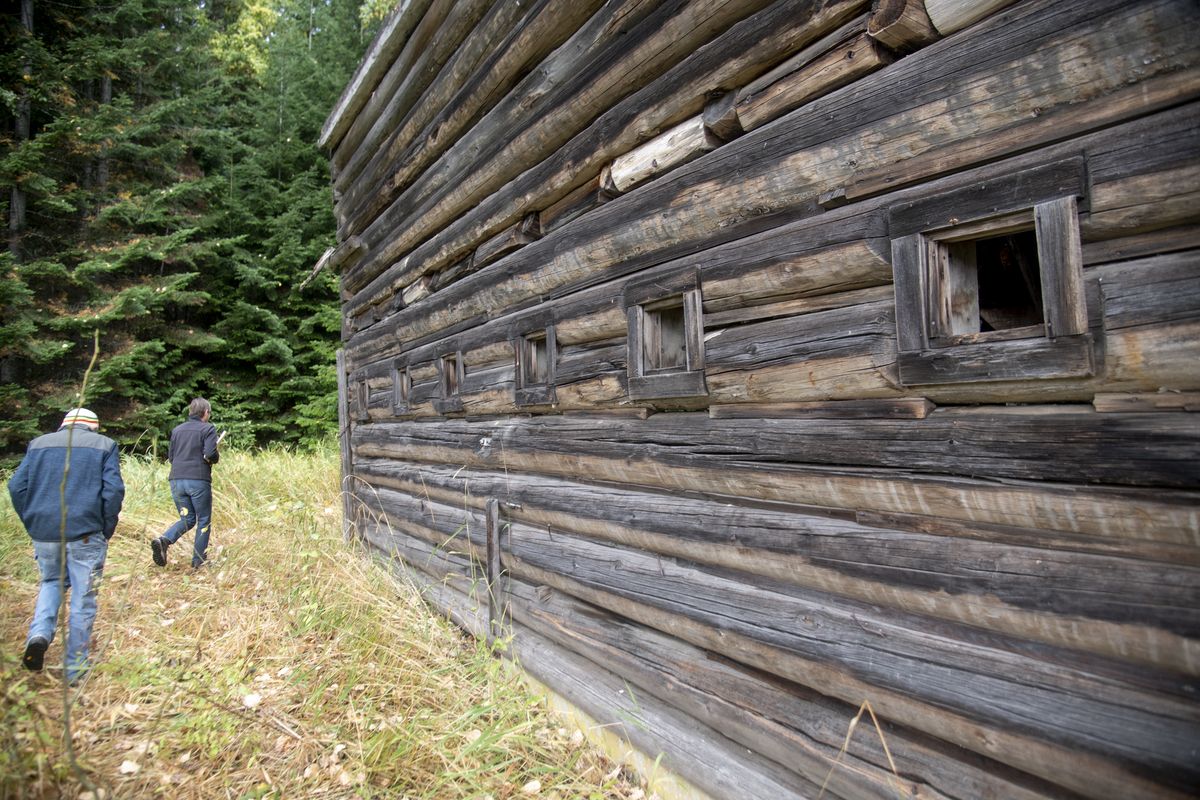Preserving history: Volunteers working toward restoring Forest Service barn near Priest Lake
Carlos Landa looks at an old barn that was part of the Bismark ranger station near Nordman, Idaho, last month. (Michael Wright/THE SPOKESMAN-REVIEW)Buy a print of this photo
NORDMAN, Idaho – At the edge of an expansive meadow here, just far enough into the forest to make the highway invisible, there’s an old log barn that isn’t much of a barn anymore.
There’s no roof – it caved in a few years ago. Decaying wood is strewn about inside. Bright green moss is growing on the walls in spots.
But it’s still standing. It still has four walls, stalls where animals once ate and drank and, if you ask Kristen Winn, a lot of potential.
Winn, a member of the Priest Lake Museum Board, is the leader of a group of dedicated history buffs that wants to restore the barn.
Built in 1919, it was once part of the Bismark Ranger Station, a U.S. Forest Service outpost that was a key base for pack teams preparing to head deeper into the woods, a place where mules could always be fed and watered. In its heyday, the barn was surrounded by a handful of other buildings, almost all of them gone, and the station was one of several surrounding Priest Lake.
Over the past century, though, the Forest Service consolidated its operations many times. Small national forests were combined to form bigger ones. Ranger stations merged. Unused buildings were razed.
That’s what happened at Bismark. A house built for the district ranger is gone. So is a bunkhouse. All that remains are two small outbuildings and this roofless barn.
When Winn looks at the barn, she doesn’t see a derelict building begging for a bulldozer. She sees an opportunity. She and her crew of volunteers want to clean it up, rebuild the roof and make it a place the public can visit. She envisions a future with events, museum tours and maybe even a return to its original purpose.
Most of all, she and the others working toward restoration see a chance to preserve a piece of physical history in a place where many of those pieces have already been lost.
“It’s one of the very few remaining Forest Service buildings in Priest Lake,” Winn said. “We just thought it’s really important to save this.”
Consolidation
The Bismark station was established in the early 1900s, during the beginnings of the Forest Service. When the station was created, it was part of the Kaniksu National Forest, which covered a broad swath of North Idaho and part of northeastern Washington. Kaniksu is believed to be an Indigenous term for priests.
In 1910, a log cabin was built on the Bismark property, according to a report prepared by a Forest Service archaeologist in 1986. At the time, Bismark was used as a summer guard station for fire patrols.
When the two-story barn was built in 1919, Bismark became a major pack base for the region. It was a place where packers could be sure their mules would get water and hay. The hay was grown in the meadow, and the report said the crop was robust enough to support pack stock from all over the Priest Lake area.
National forests are divided into geographical districts, each one managed by a ranger. In its early days, Bismark fell under the jurisdiction of the ranger headquartered in Coolin, at the southern end of the lake.
In 1927, the Forest Service decided to split the Coolin district in two – one portion would be headquartered at Falls, about 7 miles north of Priest River, and the other would be based at the Bismark station.
Bismark remained its own district for the next 36 years – through the Great Depression, through World War II, under a half-dozen presidents. The Forest Service closed some district offices around Priest Lake and consolidated them under Bismark in the 1930s and 1940s.
In the 1960s, the agency decided to build a new headquarters for the region, just a few miles from Bismark. The offices were built in 1964, and they became the Priest Lake Ranger District. Bismark reverted to its original status as a guard station.
Consolidations were common throughout the agency. A few years later, the Kaniksu forest was combined with two others in North Idaho to form the Idaho Panhandle National Forest.
The forest now covers 2.5 million acres from the St. Joe River north to Canada. It has five ranger districts. When Bismark became its own district, there were nearly that many in the forest north of Priest River alone.
Shrinking the Forest Service’s administrative footprint surely had its benefits, but it also meant there were a lot of buildings the agency didn’t need anymore. In most cases, the buildings were torn down.
Beaver Creek, a ranger station at the north end of Priest Lake that was merged with Bismark in 1940, became a campground. The structures at Coolin are gone, and the property no longer belongs to the Forest Service. The Falls District once included three houses and several outbuildings. When it was merged with the Priest Lake district in 1973, all the buildings were removed, according to the Forest Service report.
The buildings at Bismark weren’t immediately destroyed after they lost their use. There was an attempt to restore them in the 1970s, but the project fizzled. All but three buildings were dismantled – a storage shed for oil and gas, a pumphouse for the now-defunct well and the barn.
Eyes on the barn
The barn is up a nondescript gravel road off Highway 57, just a few miles south of Nordman. A person could drive by every day without knowing it’s there.
Despite that, the people who live in Priest Lake – many of them just for the summers – never forgot about it. Some have always wanted to see it spruced up.
“The community has always had our eyes on this barn,” said Carlos Landa, president of the Priest Lake Museum.
It’s still a Forest Service property, so any restoration effort had to go through officials there. That’s where previous attempts have stopped over the past couple of decades, Landa said. Agency biologists raised concerns that working on the barn and opening it to the public would harm threatened grizzly bears that often use the meadow in the spring.
“I had almost given up on it until Kristen came on our board,” Landa said.
Winn has been spending summers in Priest Lake for about a decade, living in a cabin on Forest Service land not far from Nordman and returning to Oregon for the winters.
She and her husband first went to Bismark after she read about it in a book by a local historian. They rode their bikes up the road and marveled at the aging log structure and the lush meadow out in front of it.
Winn began volunteering with the museum about four years ago and joined its board shortly after that. One year, as the board was planning its summer events, Winn suggested a walk and lecture at the former ranger station, and it was added to the schedule.
While on the walk, she and Landa started talking about what would need to be done to save the building, and all the things they could do with it.
“Artists could go in there, cub scouts and girl scouts could go in there, mule packing people could go in there. We could have community events,” she said. “That kind of sparked a new wave of people that wanted to restore this barn.”
The push began about two years ago, with Winn ginning up local support for the project. She got a wide variety of groups to write letters backing the idea – the Bonner County Museum, local chambers of commerce, the local backcountry horsemen’s group and many more.
“Everyone just kind of said, ‘Yes, we’ll support this project,’ ” she said.
They started working with the Forest Service to get permission. This fall, they got it. The agency told them the project could move forward with one caveat: no activity during the spring, when grizzly bears are most likely to use the meadow.
Marley Chynoweth, the Forest Service archaeologist for the Priest Lake district until a couple of months ago, said the project is really in its infancy. More plans still need to be developed before serious restoration work begins, but it has finally reached the starting line.
She said projects like this one often take years, if they even happen at all with the Forest Service’s limited resources.
“It’s really rare that there’s time to do any preservation work,” she said.
The difference with the Bismark barn effort, she said, is the vast support for it.
“The value of this project and the barn is really the bridge between the agency and the community,” she said.
Getting started
On a recent Tuesday, Winn and Landa drove up to the barn. The meadow glowed with fall colors. Both were planning to head to their winter homes soon, but they’ve been doing what they can to prepare the barn for restoration.
Some work had been done. A tree service had cleared the road, making it drivable. A tractor had plucked a big metal cistern from the barn’s hayloft and moved it to an old foundation. Winn and Landa had worried the cistern would fill with snow and collapse what’s left of the loft.
Winn walked in the back door of the barn. She pointed out the numbered stalls and the floorboards, in decent shape for a 104-year-old building without a roof. In one corner, she pointed to a feeding trough filled with leaves.
“This is my favorite part,” she said.
A groove was worn into the edge of the trough, right where a mule’s neck would rub while it dug for food. Winn likes to imagine mules wearing it down out of sheer boredom while stuck in the barn.
Back outside, she and Landa threw a tarp over the cistern and tightened ratchet straps to keep it in place. Doing so is meant to keep it dry this winter and, they hope, prevent rust.
They talked about the plans for the coming weeks. The tree service was supposed to come back out and clear a couple of cottonwood trees next to the barn, and they were hoping to get a tarp placed over it – a temporary replacement for its nonexistent roof.
Next year, they expect to work with a historic preservation team for the Forest Service on developing a full restoration plan. That’s when the project will really come into focus.
For now, though, they’re thrilled they’ve come this far, and that they have some momentum toward saving a piece of Priest Lake’s story.
“If we don’t do it, who’s going to?” Landa said.





